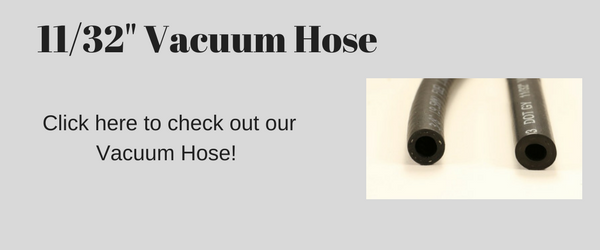How To Fix A Hard Brake Pedal
Do you have a brake pedal that feels hard to press? You may have a bad booster, booster hose, or check valve. In this 'How To' post, we offer a simple checklist to help you diagnose potential causes of a hard brake pedal. If you can't get a pedal please perform these tests before calling! Click here to download a printable PDF version of these troubleshooting tests . If you are unable to diagnose your problem and decide to give us a call, please have your customer order number ready. Our commitment is to guide you in selecting the right kit for your application and be here for you all the way through installation. The most obvious cause for a hard pedal is simply not enough vacuum. We all say that but we don't always understand what is being said. As an engine runs, it is basically an air pump that pulls vacuum. This vacuum is sourced through the intake manifold by simply tapping into an intake runner and can sometimes be ported through the baseplate on the carburetor. From the intake manifold to the brake booster will be a vacuum hose that is used to provide this vacuum. What does that mean for the brake booster and why does it matter? To understand this we must first understand how a brake booster functions. When the brake booster is at rest, the engine is pulling vacuum on both sides of the diaphragm(s) through a two-way valve inside the booster. This causes a balance within the booster and the diaphragms remain stationary. At this point the booster body is basically a reservoir storing the engine vacuum. When the brake pedal is pressed, the two-way valve internal to the booster moves in conjunction with the pedal. The valve closes the pull of vacuum to the rear of the diaphragm and the engine vacuum is only pulling on the front while atmospheric pressure is allowed into the rear of the booster. This causes the pushing of the rearward diaphragm forward while the engine vacuum pulls on the front diaphragm. This push forward is what physically applies the brakes as the internal pushrod is connected through the diaphragms. Now for the why does that matter? If the engine vacuum pulling on the diaphragms within the booster is less than that of atmospheric pressure, when the two-way valve opens, there isn't a way for the diaphragm to move as the booster almost stays in the at rest position because the difference between the front and rear is not enough to make the diaphragms to move. Your foot then becomes the means of pushing the pedal hard enough to make the movement of the diaphragms happen. To take it one step further and to further understand through numbers, we always recommend at least 18" of vacuum to be applied to the booster. Atmospheric pressure in the atmosphere at sea level is approximately 14.70 pounds per square inch. The vacuum on the front from the engine must be higher than that of the atmosphere on the rear. As you can imagine, the closer they are, the harder the pedal will be if it operates at all. Check the hose running to your booster. There are situations where the wrong type of hose is used and there are situations where the hose becomes aged or poor quality and the hose physically breaks down inside. For the wrong type of hose scenarios, what are we referring to? All hose is not created equal. Yes, it is generally black rubber with a particular ID in the center but that is where the similarities typically end. Most people assume that the vacuum hose running from the engine to the brake booster is a 3/8" ID hose. It looks just like the same size as the fuel line on the car but it is definitely different. Generally speaking, the vacuum hose for the brake booster is sized at 11/32". What typically happens is a person runs into his local parts store and asks for a 3/8" vacuum hose. The kid behind the parts counter is actually oblivious that you just asked for two different things and simply goes with what he heard first and that was 3/8" so he grabs that size. That is actually going to be fuel line. But remember, we just said there was a difference. Fuel line is used in scenarios where pressure is building within the system and the hose. That means the hose must have the ability to avoid bursting. In a vacuum situation, there is something that is acting on the hose to try and suck it shut. Therefore, the hose must be constructed in a way that prevents the hose from sucking shut. It doesn't seem like much in the terms of how much vacuum it is but trust us, it is enough to suck a fuel line closed. The best way to keep this straight in the future is to remember this simple rule. Any vacuum hose will be created and designated as __/32". For example, you will find vacuum hose in 7/32", 9/32" and 11/32" as typical sizes. The brake booster check valve could be defective. This is something easily overlooked but something very essential to the brake booster operating properly. What we are referring to is the small circular valve that goes into the body of the brake booster and what the vacuum hose actually attaches to. The function of the check valve is to hold the vacuum that the engine creates within the brake booster. If you remember the discussion earlier about how a booster works, it is basically a reservoir until the pedal is pressed. The check valve should allow vacuum to pull against the booster but not be allowed to go the other way. To determine if the check valve is functioning, remove the valve from the booster and disconnect from the hose supplying vacuum. Blow into the valve on the hose side. If air travels through and does not come out on the booster side, then you have a check valve that is functioning properly. If you are able to blow through from the hose side, then the check valve must be replaced and you have found at least one problem that could be causing your hard brake pedal. You could simply have a bad brake booster. If you remember from earlier, the booster has a front and backside with many moving parts inside. The most common failure within the booster is a diaphragm that develops a hole of the two-way valve fails to operate properly. Either way, the booster will not be able to properly house vacuum or allow the proper atmospheric pressure inside. While there isn't a quick and easy way of visually looking inside the booster, there is a there is a quick and simple way to check the booster. Follow the steps below: 1) If the pedal drops slightly, that means that the booster diaphragms are working correctly as the engine starts to create vacuum and the diaphragms are physically holding. At this point, it must be assumed the booster is working correctly. 2) If the pedal does not move at all, that says that the booster does not have the ability to hold the necessary vacuum inside or the two-way valve internal of the booster is not functioning properly. Replacement of the brake booster would be recommended at this point. The four items above are by far the most common causes of a hard feeling brake pedal. If all of these systems above check out, it's time to look at some other areas that are a little more complicated than the simple tests listed above. Here is a list of possible things to check: These are just a handful of possibilities that are very common when a customer mentions a hard pedal. Take a look at your brake system and see if any of these are causing the problem. Or, if you are ready to throw in the towel and need expert help, give us a call or drop us an e-mail and we'll get your brakes working properly so you can get your classic out of the garage and back on the road where it belongs! We invite you to Experience the Difference of Master Power Brakes - The Leader in Model Specific Brake Kits. 




Need Help?

Topics: How To Series, Hard Brake Pedal, brake valve, Brake Boosters, brake system hose
How To Fix A Hard Brake Pedal
Source: https://techtalk.mpbrakes.com/how-to-series/how-to-diagnosing-a-hard-brake-pedal
Posted by: davisanney1978.blogspot.com

0 Response to "How To Fix A Hard Brake Pedal"
Post a Comment